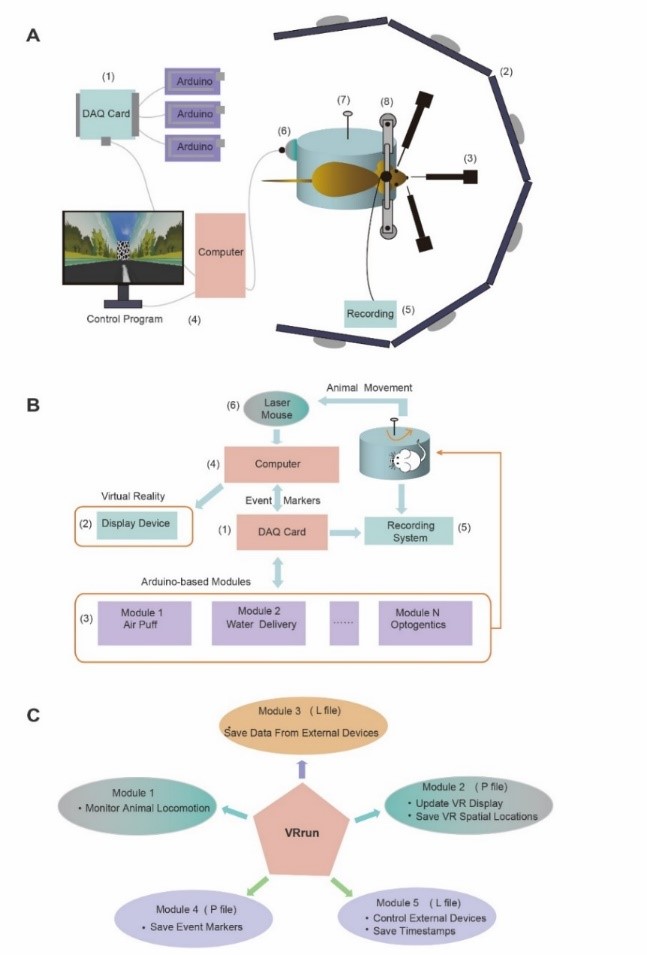Time:2022-11-10
A recent study published in Neuroscience Bulletin developed a high-performance virtual reality platform which is assembled from modular hardware and custom-written software with upgradability, providing a more economical and flexible tool for context-dependent cognitive research in rodents. This work was performed by researchers in Dr. XU Chun’s Lab and Dr. WenYunqing at the Institute of Neuroscience, Center for Excellence in Brain Science and Intelligence Technology of Chinese Academy of Science, State Key of Neuroscience, researchers in Dr. HE Hua’s group at Third Affiliated Hospital of Navy Military Medical University and researchers in Dr. LIU Yu’s lab at the Institute of Automation, Chinese Academy of Sciences.
In daily activities, animals need to respond to various environmental contexts appropriately. It is important to study context cognitive process as it’s closely linked to aspects of behaviors. The environmental context consists of various individual elements and is enriched with multisensory information. Thus, it imposes great challenges to quantitatively control the context elements and quickly switch between distinct contexts.
Virtual reality (VR) technology is instrumental in studying neural mechanisms underlying environmental-context-modulated behaviors by simulating the real world with maximized controls of context elements while being compatible with head-fixed neural recordings. The researchers designed a high-performed VR platform and its main hardware structure included six curved screens, a styrofoam cylinder, a motion detector, the neural activity recording device, and peripheral functional modules which could be assembled according to the experimental needs. Rapid display switching and interactive immersive VR experience were achieved through multi-thread processing of position detection, real-time screen update, peripheral device triggering and mouse behavioral parameters by custom-written software.
Using this VR platform, researchers trained mice to perform context-dependent cognitive tasks with rules ranging from discrimination to delayed-sample-to-match while recording thousands of hippocampus place cells. In the context recognition task, mice showed a licking preference at specific reward areas after learning. By precise manipulations of context elements, researchers further found that the context recognition was intact with partial context elements or even a small proportion (1/4) of interfering elements from an opposite context. In the context-dependent delayed-sample-to-match task, mice also showed successful learning of the match/non-match rules, demonstrating the potential of this VR platform in complex cognitive tasks.
Compared with previous experimental VR devices, the VR platform developed in this study is flexible, widely applicable, cost-effective, and easy to use. Its lightweight software and upgradeable hardware modules can be assembled according to the needs of different experimental tasks. This study preliminarily explores the role of elements in the context recognition process and establishes a more convenient VR platform to investigate context-dependent cognition with large-scale neural recording.
This work entitled “A Virtual Reality Platform for Context-Dependent Cognitive Research in Rodents” was published online in Neuroscience Bulletin on Nov 8, 2022. QU Xuetong, WU Jinni, and WEN Yunqin are the co-first authors with equal contribution. This work was supported by MOST, CAS and NSFC.


Figure 1. The hardware and functional modules of software for the VR platform.
(A) The cartoon showing the assembly of the VR platform. The components are (1) the DAQ card, (2) the six LCD screens covering 270° view angle for VR display, (3) Arduino-based modules connected with the DAQ card, (4) the computer, (5) the neural recording system, (6) a laser mouse, (7) a styrofoam cylinder and (8) a head fixation setup.
(B) The organization chart of VR platform.
(C) Five functional modules of the control program (VRrun).”
Key words: Virtual reality, Spatial context, Contextual behaviors, Hippocampus, Place cells
Full text links:
https://pubmed.ncbi.nlm.nih.gov/36346582/
AUTHORS CONTACT:
XU Chun
Center for Excellence in Brain Science and Intelligence Technology, Chinese Academy of Sciences, Shanghai, China.
E-mail: chun.xu@ion.ac.cn
More information for Xu Chun’s Lab http://english.cebsit.cas.cn/lab/xuchun/research/
 附件下载:
附件下载: